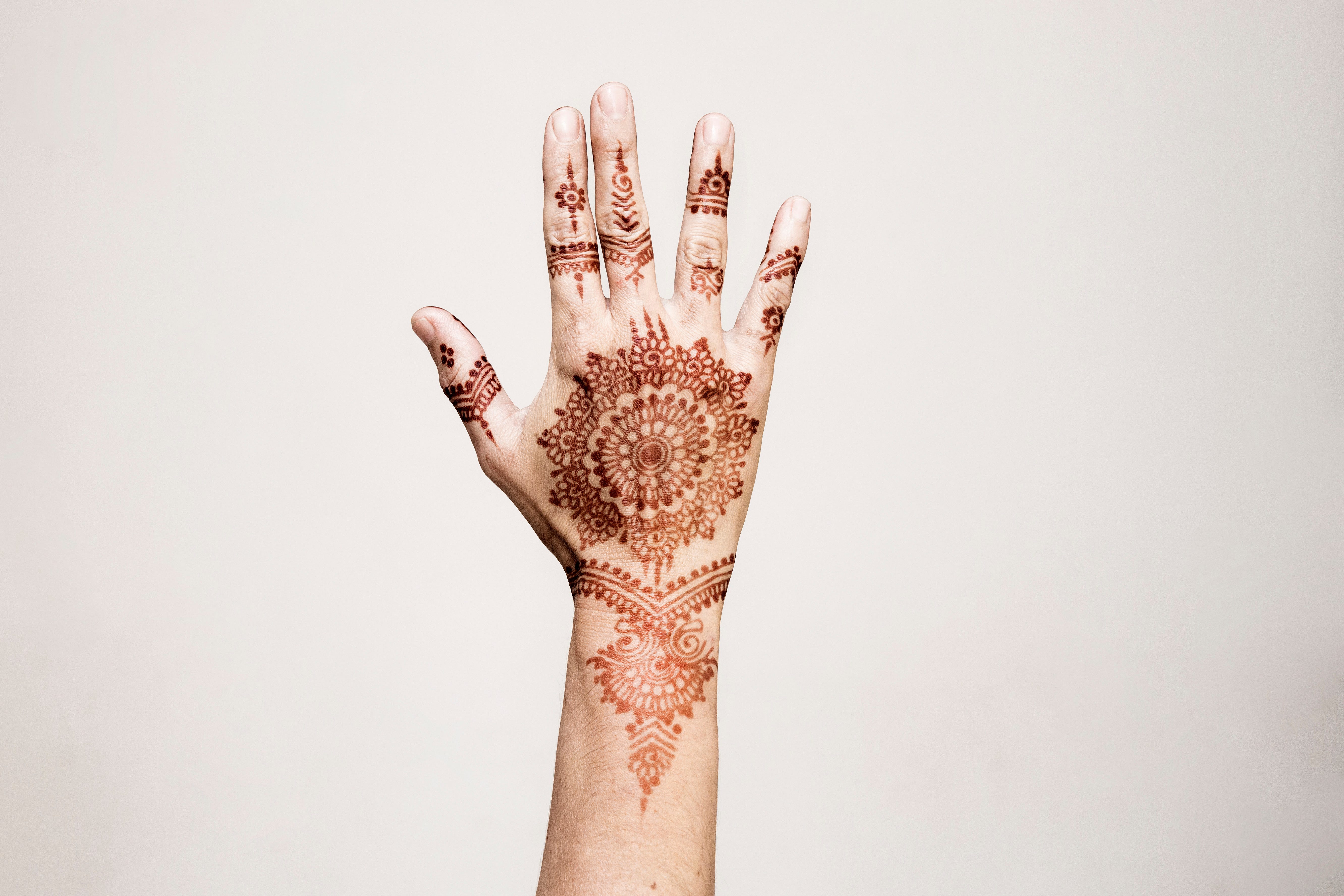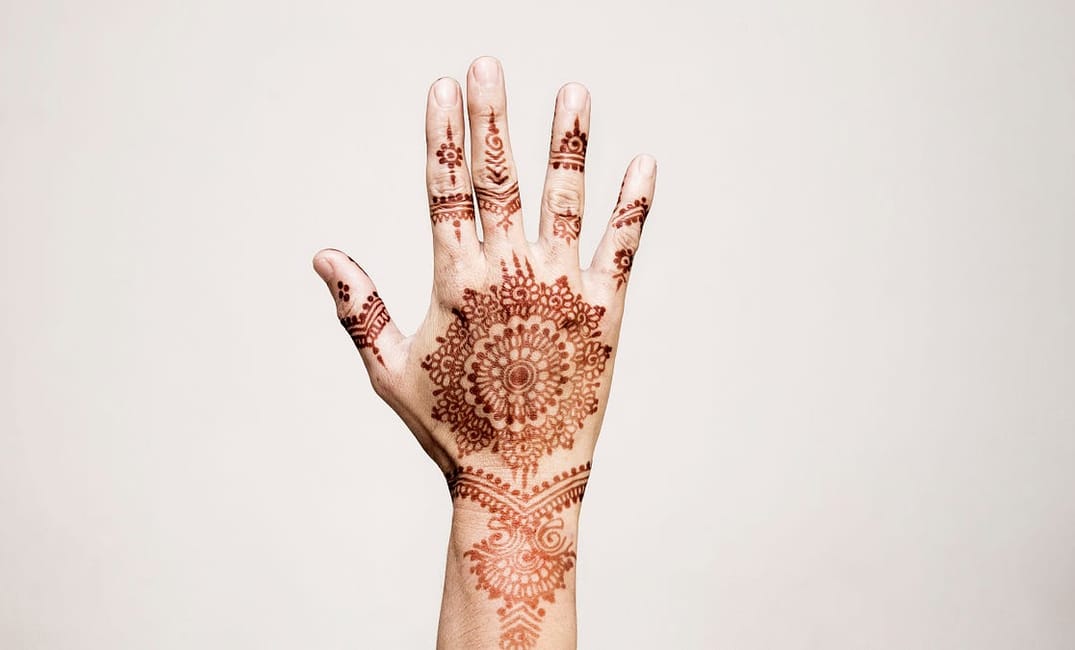
After spotting my henna-stained palms one day in grade school, my schoolmate blurted out:
“What is that disease?”
I glanced down at my once rich and complicated patterns, now faded into leopard-like spots of yellow and brown on my skin. This type of interaction was hardly the first or last of its kind, but it’s one of the earliest memories I have of feeling ashamed to be Indian.
Henna, or mehndi, is traditionally worn during celebratory occasions, and I had gotten it done at a wedding celebration over the weekend. Amid joyous melodies and bites of savory snacks and sweet treats, women and girls had lined up at the mehndi artist’s table for their turn. Across the room, the bride sat upon her makeshift throne of colorful linens, arms and legs outstretched onto plush cushions. She had accepted bites of food from doting family while her dedicated artist painted her limbs with paisleys and peacocks, camouflaging her betrothed’s name within elegant mandalas and flowers. As is custom, his love for her will later be tested when he scans the delicate designs for his moniker.
Sign-up for The Bold Italic newsletter to get the best content about life in the Bay Area in your inbox every week. What could go wrong?
It’s a tradition that dates back thousands of years, and even as a child, I wore these deep red stains with immense pride and dreamt of the day when I, too, would be adorned with mehndi like a traditional bride.
But in an instant, my schoolmate’s ignorant sneers deflated me. Admittedly, living in An Extremely Small Town, Texas, I could hardly expect my peers to know, let alone appreciate, this ancient art form. It wasn’t too long before then that I had explained to the awestruck audience that Indians (the ones actually from India) were, in fact, from Asia. Still, it impressed upon my young mind that mehndi was too different to be celebrated in America. While I never stopped loving it, I tried to avoid showing up to school wearing the designs for many years afterward.
Meanwhile, mehndi and other Eastern traditions like wearing a bindi (a colored dot worn on the center of the forehead) gained popularity in the West after Madonna sported a henna “tattoo” in her 1998 “Frozen” music video and Gwen Stefani set fire to a new, quirky fashion trend by donning bejeweled stickers on her third eye. It wasn’t long before henna tattoos were all the rage in mall kiosks and carnivals, and in time, more girls — white girls — were stocking up on their bindi “body jewelry” from the local Claire’s.
I was, along with many brown girls like me, truly excited about these shifts. My culture had arrived, it seemed — albeit on the wings of these fair-skinned goddesses, but here it was on America’s center stage.
It was finally cool to be me.
I was certain that if it didn’t have a white person’s stamp of approval, it must be full of shit.
Twenty years later, I am now living in San Francisco, where the residents’ appetite for all things Indian (or ambiguously South Asian) is so insatiable, it’s almost comical. I can’t walk through a single neighborhood without passing at least one yoga studio, where teachers more often than not cherry-pick their knowledge of yoga and then propagate it to spiritually hungry students. It took me many years of classes at various studios around the city before I, too, learned how to ignore the flagrant inaccuracies in these Western yoga classes and take away just what I need: a guided session through the physical practice. Nothing more, nothing less.
“The light in me honors the light in you. Namaste,” regurgitates every teacher at the end of every class as if reading from a fictional Westerner’s Manual for Teaching Authentic Yoga. Out of respect, I always join my hands and give a quick half-bow. While I jump up to gather my things, some are still prostrating deeply. I wonder what they’d say if I told them most Indians find this use of “namaste,” a term used in greetings, pretty silly.
I wonder why I even feel compelled to honor this contrived tradition. Although I’ve thought about it a hundred times, I’ve never once spoken to a teacher after class to offer corrections. After spending 25 years striving to assimilate, I sometimes question whether advocating to preserve my culture’s social customs is being too sensitive, even unappreciative: If that’s how they teach yoga in America, shouldn’t I just accept it?
As with mehndi and yoga, the introduction of chai was initially exciting. When India’s national drink appeared on the menu at Starbucks—America’s favorite coffee shop—it was a call for celebration. It was slightly annoying when chai, which literally means “tea” in Hindi, became a sensation as “chai tea latte.” The first time I saw a coffee shop selling the ever-popular “golden milk latte,” I scoffed in disbelief.
Here we go again, I thought.
Turmeric, the West’s new darling spice, had begun to make its way into everything. I could forgive the vegan chefs for dowsing tofu scrambles with copious amounts of the yellow spice as excited naiveté. (Spoiler alert: Turmeric does not make tofu taste like eggs.) But “introducing” a classically Indian drink and remarketing it as an exotic elixir touched a familiar nerve.
Every morning, I used to pass an A-frame on the way to work that advertised a cashew-based “golden milk.” As a vegan, I am this ad’s ideal target. And I was intrigued. Guiltily, I was also reminded of the years I ridiculed my dad for drinking halad doodh, which literally means “turmeric milk” in Gujarati. Turmeric was a staple in our kitchen, as it is in the kitchens of Indians everywhere. It was so ubiquitously in our food that it enjoyed a permanent residence in my mom’s masala dabba, or spice tin.
“Just remember that almost every shaak (vegetable stir-fry) uses the same few spices,” my mom taught me early on. “Mustard seeds, cumin, coriander, turmeric, chili, salt.” This rule of thumb is the framework for Gujarati cuisine, and I still default to it when in doubt.
The golden milk mania, as with henna tattoos and bindi body jewelry before it, is founded in Western society’s ability to remarket cultural traditions until their inherent brownness is paled enough to look white.
Today, turmeric is widely celebrated for its anti-inflammatory benefits and antioxidant properties. Fair-skinned goddesses swear by it. But this skin-yellowing spice mixed with milk was the least American drink I could imagine as a kid — and it sounded disgusting to boot. The American airwaves were blasting ads for velvety, chocolate-flavored Nesquik and Ovaltine, ardently approved by kids unlike me but after whom I modeled myself. Kids whose homes smelled like hamburgers and freshly baked chocolate chip cookies, not aromatic spices and basmati rice. But my dad, blissfully impervious to the Western ideals that ruled my existence, insisted on drinking this yellow, spiced milk for its many health benefits. Not only did I take a hard pass on it, but I also dismissed any grounds for validity.
Call it typical childish brattiness or burgeoning Western ethnocentrism (I think it was a bit of both), but I was certain that if it didn’t have a white person’s stamp of approval, it must be full of shit.
I’m currently smitten with a certain coffee drink on the menu at Ritual Coffee in my neighborhood. The irony is not lost on me that “The Golden Lady” is nothing more than a remixed version of halad doodh with a shot of espresso. With every divine sip, I’m resigned to believing that I’m the ultimate sellout. The guilt is intermingled with a familiar bitterness, and the resentment, dormant but always present, bubbles up again. The golden milk mania, as with henna tattoos and bindi body jewelry before it, is founded in Western society’s ability to remarket cultural traditions until their inherent brownness is paled enough to look white. Only then does it become palatable enough for the masses.
There is a fine line between cultural appreciation and cultural appropriation, and I find that the vast majority of people outside the diaspora are constantly treading it.
It’s the same twisted ideology I accepted for most of my life. While I grapple with the hypocrisy of my own participation in these white-washed practices, I can’t help but also feel comforted by the familiarity and modernity of it all. A large part of my “anti-Indian-ness” stemmed from my inability to see eye-to-eye with my immigrant parents. I spent most of my energy balancing my dual identity: a well-behaved, cultured, Gujarati-speaking Indian kid at home and a cool, just-interesting-enough, English-speaking American kid at school.
My attempts at melding the two were largely a failure (i.e. “diseased” henna), and it wasn’t until Madonna and Gwen Stefani blessed Indian culture with their magical white touch that girls like me enjoyed a moment in the sun — to be ourselves, fully, without the risk of being disloyal to half of our identities.
Would I prefer it didn’t have to be this way? Of course.
Do I wish the descendants of India’s colonizers weren’t now also profiting off its treasures in a completely new way? Obviously.
There is a fine line between cultural appreciation and cultural appropriation, and I find that the vast majority of people outside the diaspora are constantly treading it.
I also know that not every aum-chanting yoga teacher is oblivious to their responsibility as a steward of the ancient practice. Some are truly aiming to spread the message of yoga because it has been transforming for them. There’s Holly, my yoga teacher friend from work, for example, who bemoans yoga-bleaching with me. She listens with the impartial ear of a therapist, offering equal amounts of gratitude and remorse. Thank you, she tells me, for sharing my unfiltered story. I’m sorry, she continues, that more people from outside the culture don’t take the time to have conversations like this. I’m sorry, too, I tell her.
Begrudgingly, I’ll admit that I may never have come to appreciate things like halad doodh had I not been reintroduced to it in a way that was more familiar to me, as a coffee-drinking American. And part of me is grateful to live in a place so infatuated with Indian everything that I can wear mehndi at any time, anywhere, and no one will blink an eye. Because I haven’t changed all that much from that girl who dreamed of wearing mehndi sleeves like a bride all day, every day.
I’ve learned to see the bright side of things, but my childhood memories still leave me bitter at times. I still want to throw up every time I see a “Ganesha Is My Om Boy” T-shirt paired with the latest Lululemons on a woman strutting out of yoga class. It’s a reminder that there’s still so much work to do in educating the masses about where cultural appreciation ends and cultural appropriation begins.
So, barista, you may as well keep the Golden Lady drinks coming.







